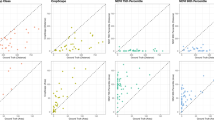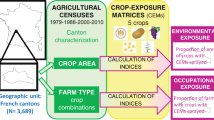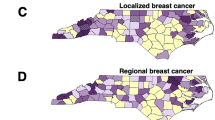Abstract
In recent years, geographic information systems (GIS) have increasingly been used for reconstructing individual-level exposures to environmental contaminants in epidemiological research. Remotely sensed data can be useful in creating space-time models of environmental measures. The primary advantage of using remotely sensed data is that it allows for study at the local scale (e.g., residential level) without requiring expensive, time-consuming monitoring campaigns. The purpose of our study was to identify how land surface remotely sensed data are currently being used to study the relationship between cancer and environmental contaminants, focusing primarily on agricultural chemical exposure assessment applications. We present the results of a comprehensive literature review of epidemiological research where remotely sensed imagery or land cover maps derived from remotely sensed imagery were applied. We also discuss the strengths and limitations of the most commonly used imagery data (aerial photographs and Landsat satellite imagery) and land cover maps.
This is a preview of subscription content, access via your institution
Access options
Subscribe to this journal
Receive 6 print issues and online access
$259.00 per year
only $43.17 per issue
Buy this article
- Purchase on Springer Link
- Instant access to full article PDF
Prices may be subject to local taxes which are calculated during checkout



Similar content being viewed by others
References
Atkinson S.F., Waller W.T., and Crooks T.J. Assessing atrazine pollution potential to a drinking water reservoir using remote sensing and geographic information system modeling. Aquatic Ecosystem Health and Management 2001: 4: 327–338.
AvRuskin G.A., Jacquez G.M., Meliker J.R., Slotnick M.J., Kaufmann A.M., and Nriagu J.O. Visualization and exploratory analysis of epidemiologic data using a novel space time information system. Int J Health Geogr 2004: 3: 26.
Avruskin G.A., Meliker J.R., and Jacquez G.M. Using Satellite Derived Land Cover Information for a Multi-Temporal Study of Self-Reported Recall of Proximity to Farmland. J Expo Sci Environ Epidemiol 2008: 18: 381–391.
Ayotte J.D., Nolan B.T., Nuckols J.R., and Cantor K.P. Modeling the probability of arsenic in groundwater in New England as a tool for exposure assessment. Environ Sci Technol 2006: 40: 3578–3585.
Bassani C., Cavalli R.M., Cavalcante F., Cuomo V., Palombo A., Pascucci S., and Pignatti S. Deterioration status of asbestos-cement roofing sheets assessed by analyzing hyperspectral data. Remote Sensing of Environment 2007: 109: 361–378.
Beyea J., and Hatch M. Geographic exposure modeling: a valuable extension of geographic information systems for use in environmental epidemiology. Environ Health Perspect 1999: 107 (suppl 1): 181–190.
Boscoe F.P., Ward M.H., and Reynolds P. Current practices in spatial analysis of cancer data: data characteristics and data sources for geographic studies of cancer. Int J Health Geogr 2004: 3: 28.
Brody J.G., Vorhees D.F., Melly S.J., Swedis S.R., Drivas P.J., and Rudel R.A. Using GIS and historical records to reconstruct residential exposure to large-scale pesticide application. J Expo Anal Environ Epidemiol 2002: 12: 64–80.
Dappen P., and Tooze M. Delineation of Land Use Patterns for the Cooperative Hydrology Study in The Central Platte River Basin, University of Nebraska-Lincoln, Center for Advanced Land Management Information Technologies Report 2001 73p.
Datcu M., D’Elia S., King R.L., and Bruzzone L. Introduction to the special section on image information mining for Earth observation data. IEEE Trans Geosci Remote Sens 2007: 45: 795–798.
Elliott P., Briggs D., Morris S., de Hoogh C., Hurt C., Jensen T.K., Maitland I., Richardson S., Wakefield J., and Jarup L. Risk of adverse birth outcomes in populations living near landfill sites. BMJ 2001: 323: 363–368.
Gail W.B. Remote sensing in the coming decade: the vision and the reality. J Applied Remote Sensing 2007: 1: 1–19.
Galton A Desiderata for a spatio-temporal geo-ontology. In: Kuhn W., Worboys MF., Timpf S., (Eds) Spatial Information Theory: Foundations of Geographic Information Science, Lecture Notes in Computer Science Volume 2825/2003 Springer-Verlag: Berlin, 2003, 1–12.
Garland C.F., Mohr S.B., Gorham E.D., Grant W.B., and Garland F.C. Role of ultraviolet B irradiance and vitamin D in prevention of ovarian cancer. Am J Prev Med 2006: 31: 512–514.
GEO. 2005. Global Earth Observing System of Systems (GEOSS) - 10-year Implementation Plan Reference Document, Tech. Rep. GEO 1000R/ESA Publications Division, The Netherlands, 210p; http://earthobservations.org/documents/10-Year%20Plan%20Reference%20Document.pdf; accessed July 2008).
Guidry V.T., and Margolis L.H. Unequal respiratory health risk: Using GIS to explore hurricane related flooding of schools in Eastern North Carolina. Environ Res 2005: 98: 383–389.
Guo D., Chen J., MacEachren A.M., and Liao K. A Visualization System for Space-Time and Multivariate Patterns (VIS-STAMP). IEEE Trans Vis Comput Graph 2006: 12: 1461–1474.
Herbreteau V., Salem G., Souris M., Hugot J., and Gonzalez J. Thirty years of use and improvement of remote sensing, applied to epidemiology: from early promises to lasting frustration. Health Place 2007: 13: 400–403.
Homer C., Dewitz J., Fry J., Coan M., Hossain N., Larson C., Herold N., McKerrow A., VanDriel J.N., and Wickham J. Completion of the 2001 National Land Cover Database for the conterminous United States. Photogrammetric Engineering and Remote Sensing 2007: 73: 337–341.
Jacquez G.M., Greiling D., and Kaufmann A. Design and implementation of space time information systems. J Geogr Syst 2005: 7: 7–24.
Jenson F.R. Remote sensing of the Environment: an Earth Resource Perspective. 2nd edn. Prentice Hall: Upper Saddle River, NJ, 2007.
Landgrebe D. The evolution of Landsat data analysis. Photogrammetric Engineering and Remote Sensing 1997: 63: 859–867.
MacConnell W.P., Goodwin D.W., and Jones K.M.L. Land-use update for Cape Cod with area statistics for 1971, 1984 and 1990. Research Bulletin Number 737. Massachusetts Agricultural Experiment Station, University of Massachusetts at Amherst, College of Food and Natural Resources, 1991.
MacConnell W.P. Remote sensing 20 years of change in Massachusetts 1951/52–1971/72. Research Bulletin Number 630. Massachusetts Agricultural Experiment Station, University of Massachusetts at Amherst, College of Food and Natural Resources, 1975.
Marusek J.C., Cockburn M.G., Mills P.K., and Ritz B.R. Control selection and pesticide exposure assessment via GIS in prostate cancer studies. Am J Prev Med 2006: 30(2 Suppl): S109–S116.
Mather F.J., Whited L.C., Langlois E.C., Shorter C.F., Swalm C.M., Shaffer J.G., and Harley W.R. Statistical methods for linking health, exposure and hazards. Environ Health Perspect 2004: 112: 1440–1445.
Matthijsen J., Slaper H., Reinen H.A.J.M., and Velders G.J.M. Reduction of solar UV by clouds: a comparison between satellite-derived cloud effects and ground-based radiation measurements. J Geophys Res-Atmospher 2000: 105: 5069–5080.
Maxwell S.K., Wood E.C., and Janus A. Comparison of the USGS 2001 NLCD to the 2002 USDA Census of Agriculture for the Upper Midwest United States. Agric Ecosyst Environ 2008: 127: 141–145.
Maxwell S.K., Nuckols J.R., and Ward M.H. A method for mapping corn using the US Geological Survey 1992 National Land Cover Dataset. Computers and Electronics in Agriculture 2006: 51: 54–65.
McNamee R., and Dolk H. Does exposure to landfill waste harm the fetus? BMJ 2001: 323: 351–352.
Meliker J.R., Slotnick M.J., AvRuskin G.A., Kaufmann A., Fedewa S.A., Goovaerts P., Jacquez G.M., and Nriagu J.O. Individual lifetime exposure to inorganic arsenic using a Space-Time Information System. Int Arch Occ Env Health 2007: 80: 184–197.
Meliker J.R., Slotnick M.J., AvRuskin G.A., Kaufmann A., Jacquez G.M., and Nriagu J.O. Improving exposure assessment in environmental epidemiology: Application of spatio-temporal visualization tools. J Geogr Syst 2005: 7: 49–66.
Meyer K.J., Reif J.S., Veeramachaneni D.N.R., Luben T.J., Mosley B.S., and Nuckols J.R. Agricultural pesticide use and hypospadias in Eastern Arkansas. Environ Health Perspect 2006: 114: 1589–1595.
Mohr S.B., Garland C.F., Gorham E.D., Grant W.B., and Garland F.C. Is ultraviolet B irradiance inversely associated with incidence rates of endometrial cancer: an ecological study of 107 countries. Prev Med 2007: 45: 327–331.
Mohr S.B., Gorham E.D., Garland C.F., Grant W.B., and Garland F.C. Are low ultraviolet B and high animal protein intake associated with risk of renal cancer? Int J Cancer 2006: 119: 2705–2709.
Monmonier M. Aerial photography at the agricultural adjustment administration: acreage controls, conservation benefits, and overhead surveillance in the 1930s. Photogrammetric Engineering and Remote Sensing 2002: 68: 1257–1261.
Nieuwenhuijsen M., Paustenbach D., and Duarte-Davidson R. New developments in exposure assessment: The impact on the practice of health risk assessment and epidemiological studies. Environ Intl 2006: 32: 996–1009.
Nuckols J.R., Ward M.H., and Jarup L. Using Geographic Information Systems for Exposure Assessment in Environmental Epidemiology Studies. Environ Health Persp 2004: 112: 1007–1015.
O’Leary E.S., Vena J.E., Freudenheim J.L., and Brasure J. Pesticide Exposure and Risk of Breast Cancer: a nested Case-Control Study of Residentially Stable Women Living on Long Island. Environ Res 2004: 94: 134–144.
Piacentini R.D., Cede A., Luccini E., and Stengel F. Determination of the UV solar risk in Argentina with high-resolution maps calculated using TOMS ozone climatology. Adv Space Res 2004: 34: 2215–2220.
Pickle L., Waller L., and Lawson A.B. Current Practices in cancer spatial data analysis: a call for guidance. Int J Health Geogr 2005: 4: 3.
Pickle L.W., Szczur M., Lewis D.R., and Stinchcomb D.G. The crossroads of GIS and health information: a workshop on developing a research agenda to improve cancer control. Int J Health Geog 2006: 5: 51.
Reif J.S., Burch J.B., Nuckols J.R., Metzger L., Ellington D., and Anger W.K. Neurobehavioral effects of exposure to trichloroethylene through a municipal water supply. Environ Res 2003: 93: 248–258.
Reynolds P., Hurley S.E., Gunier R.B., Yerabati S., Quach T., and Hertz A. Residential proximity to agricultural pesticide use and incidence of breast cancer in California, 1988–1997. Environ Health Perspect 2005: 113: 993–1000.
Riggs P.D Assessing multiple geospatial modeling techniques of assigning pesticide exposure in the California central valley. [PhD Thesis]. Colorado State University: Fort Collins, CO, 2007.
Rull R.P., Ritz B., and Shaw G.M. Validation of self-reported proximity to agricultural crops in a case-control study of neural tube defects. J Expo Sci Environ Epidemiol 2006: 16: 147–155.
Ryan P.H., and LeMasters G.K. 2007. A review of land-use regression for characterizing intraurban air models pollution exposure. Inhal Toxicol 2007: 19: 127–133.
Slaper H., Velders G.J.M., and Matthijsen J. Ozone depletion and skin cancer incidence: A source risk approach. J Hazard Mater 1998: 61: 77–84.
Solomon C.C., White E., Kristal A.R., and Vaughan T. Melanoma and lifetime UV radiation. Cancer Causes Control 2004: 15: 893–902.
Tatalovich Z., Wilson J.P., Mack T., Yan Y., and Cockburn M. The objective assessment of lifetime cumulative ultraviolet exposure for determining melanoma risk. J Photochem Photobiol B 2006: 85: 198–204.
Thogmartin W.E., Gallant A.L., Knutson M.G., Fox T.J., and Suarez M.J. Commentary: A cautionary tale regarding use of the National Land Cover Dataset 1992. Wildlife Society Bulletin 2004: 32: 970–978.
US Geological Survey. Imagery for everyone… timeline set to release entire USGS Landsat archive at no charge, Technical Announcement April 21, 2008. Available: http://landsat.usgs.gov/images/squares/USGS_Landsat_Imagery_Release.pdf [accessed July 2008]. 2008.
US Geological Survey National Gap Analysis Program. Provisional Digital Land Cover Map for the Southwestern United States. Version 1.0. RS/GIS Laboratory, College of Natural Resources, Utah State University, 2004. Available: http://ftp.nr.usu.edu/swgap/swregap_landcover_report.pdf [accessed July 2008].
Vogelmann J.E., Howard S.M., Yang L., Larson C.R., Wylie B.K., and Van Driel J.N. Completion of the 1990's National Land Cover Data Set for the conterminous United States. Photogrammetric Engineering and Remote Sensing 2001: 67: 650–662.
Ward M.H., Lubin J., Giglierano J., Colt J.S., Wolter C., Bekiroglu N., Camann D., Hartge P., and Nuckols J.R. Proximity to crops and residential exposure to agricultural herbicides in Iowa. Environ Health Perspect 2006: 114: 893–897.
Ward M.H., Nuckols J.R., Weigel S.J., Maxwell S.K., Cantor K.P., and Miller R.S. Identifying populations potentially exposed to agricultural pesticides using remote sensing and a geographic information system. Environ Health Perspect 2000: 108: 5–12.
Weaver C., Fyfe D., Robinson A., Holdsworth D., Peuquet D., and MacEachren A.M. Visual Analysis of Historic Hotel Visitation Patterns. IEEE Trans Vis Comput Graph 2006: 12: 35–42.
Xiang H.Y., Nuckols J.R., and Stallones L.A. Geographic information assessment of birth weight and crop production patterns around mother's residence. Environ Res 2000: 82: 160–167.
Yu C.L., Wang S.F., Pan P.C., Wu M.T., Ho C.K., Smith T.J., Li Y., Pothier L., and Christiani D.C. Residential exposure to petrochemicals and the risk of leukemia: Using Geographic Information System Tools to estimate individual-level residential exposure. Am J Epidemiol 2006: 164: 200–207.
Zhu Z., Yang L., Stehman S.V., and Czaplewski R.L. Accuracy assessment for the US Geological Survey regional land cover mapping program: New York and New Jersey Region. Photogrammetric Engineering and Remote Sensing 2000: 66: 1425–1435.
Acknowledgements
We thank Carol Deering and Eric Wood for assisting with the library searches and collecting the literature for this study. This work was performed under BioMedware contract HHSN261200700061C and USGS contract 03CRCN0001.
Author information
Authors and Affiliations
Corresponding author
Rights and permissions
About this article
Cite this article
Maxwell, S., Meliker, J. & Goovaerts, P. Use of land surface remotely sensed satellite and airborne data for environmental exposure assessment in cancer research. J Expo Sci Environ Epidemiol 20, 176–185 (2010). https://doi.org/10.1038/jes.2009.7
Received:
Accepted:
Published:
Issue Date:
DOI: https://doi.org/10.1038/jes.2009.7
Keywords
This article is cited by
-
A review on the application of the exposome paradigm to unveil the environmental determinants of age-related diseases
Human Genomics (2022)
-
Field Study of Longshore Sediment Transport Rate Estimation over the Newly-Developed Coastline of Northern Oman Sea
KSCE Journal of Civil Engineering (2022)
-
People and Pixels 20 years later: the current data landscape and research trends blending population and environmental data
Population and Environment (2019)
-
Rapid Crop Cover Mapping for the Conterminous United States
Scientific Reports (2018)



